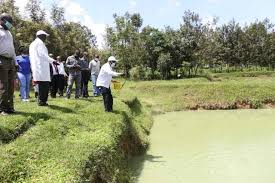
Endowed with rainfall all-year-round and a population big enough to constitute a huge market for fish, Kakamega county has for generations looked to Lake Victoria for this important food resource rich in protein.
Things are changing fast, and as the world explores ways and means of scaling up supply, Kakamega county has joined the party, and since last year the devolved unit of government has been technically and financially supporting farmers to produce enough for local consumption and export.
Now with demand on the spin vis-a-vis dwindling supply, the Kakamega government has ploughed into the programme some Ksh20.4 million ($20,000) since 2016, with the initial phase targeting 489 farmers distributed in all the 12 sub-counties.
The offshoot of the programme is the construction a fish processing factory in Kakamega town. The main fish species under the project are the popular tilapia, African catfish common carp and rainbow trout, which fetch roughly Ksh400 ($4) per piece and take three-four months to be ready for the market.
County industrialisation and trade executive Kassim Were says successful implementation of the programme that targets 7,000 fish ponds that will supply five tonnes of fish per day will further diversify the local economy that hitherto depends on sugarcane, maize and dairy farming. However, continued subdivision of agricultural land into smallholdings has rendered available land for farming uneconomical for commercial production of the two crops and livestock keeping, hence the steep decline in output.
The project further received impetus from the national government in the run-up to the 2018 Sustainable Blue Economy Conference in Nairobi attended by 18,000 participants from around the world. The conference provided a glimpse of the economic potential of fish-farming in regions without lakes or big rivers like Kakamega.
At present, Kenya is rated fourth among major producers of aquaculture in Africa, having multiplied output from 4,218 tonnes in 2006 to 29,096 tonnes in 2014 courtesy of fish farming. More than a quarter of the exports are from fish farms in the continent’s hinterland like Kakamega and adjoining regions.
Central Kenya and the Rift Valley regions, where fish was equated to snakes, have taken the lead in the fish-farming and reaping from the growing urban population in Nairobi, Kiambu, Nakuru, Nyeri, Murang’a and Eldoret, among others.
According to the ministry of agriculture, livestock and fisheries, fish contributed 0.8 per cent to the Kenya’s gross domestic product (GDP) equivalent of Ksh40.4 billion shillings ($40.4 million) in 2014.
Agricultural and economic experts estimate that Kenya’s fish potential is far higher than the current output. They project the country is capable of producing over 11 million tonnes of fish valued at Ksh750 billion shillings ($750 million) per annum.
While the outcome of the conference has not been made public to give Kenyan farmers an inkling of the economic and dietary benefits to be derived from aquaculture, snippets of information gleaned from the conference papers gave the Kakamega county government and farmers a fillip of how position fish-farming as a commercial undertaking with high economic returns.
The programme got underway last year when 489 farmers were each given 1,000 fingerings for a total 489,000 fingerlings in the preliminary phase of the project expected to increase fish consumption in the county. According to the 2019 census, Kakamega county has an estimated resident population of two million people.
With most farmers owning less than 10 acres of land, says Kakamega Fish Factory investor Samuel Ondiek, fish farming is expected to diversify farmers’ income streams in addition to food security.
The region’s main source of fish, Lake Victoria situated 54 kilometres west of Kakamega town, is, as a result of invasive water hyacinth, uncontrolled disposal of toxic industrial effluent, human waste and territorial disputes among the three East African states – Kenya, Uganda and Tanzania – that share the lake waters, experiencing a decline in marine.
In addition, environmental degradation upstream, the major rivers empty into Lake Victoria are polluted by chemicals used in crop farming, hence interfering with fish breeding cycles. Population explosion in the Lake Victoria basin has also exerted further pressure on marine resources in the world’s second largest fresh water lake.
Consequently, says Kakamega County Deputy Governor Philip Kutima, there is a need to produce fish to meet the nutritional requirements of the rapid population increase, besides setting the groundwork for business and industrial development of the county.
During the launch of the programme last year, Prof Kutima, who doubled up as county executive for agriculture, outlined plans for commercial fish farming and a fish processing plant last year.
“The county government has introduced the programme to increase fish production, improve nutrition among residents and increase income for farmers. We will engage with our farmers on a cost-sharing basis, whereby as a government, we will purchase quality fish feeds for farmers and they in turn pay for the fingerlings,” announced Prof Kutima.
The Kakamega regional government picked the cue from national – by extension global – economic trends in which the blue economy plays an integral role in providing food security, generates employment and protect riparian lands around natural water bodies.
United Nations Food and Agricultural Organisation says consumption in Kenya has been declining from a modest six kilogrammes per caput in 2000 to 4.5 kilogrammes per caput in 2011.
“The value of fish exports was about $62.9 (Ksh63 billion) in 2012 or about five times greater than the U$12.3 million (Ksh12.5 billion) in fish imports. In 2013, around 129,300 people derived their livelihood from fishing and fish farming activities (including 48,300 in inland waters, 13,100 in coastal waters fishing and around 67,900 in fish farming),” FAO says.
The organisation predicts a turnaround fish production with fish farming outpacing freshwater lakes – Naivasha and Victoria – and Rift Valley saline lakes.
“Total fishery and aquaculture production in 2013 amounted to 186,700 tonnes, with 83 per cent coming from inland capture fisheries (of which Lake Victoria contributed about 90 per cent). Catches of Nile perch – the most sought after and mainly exported fish species – seriously declined due to overfishing after the 2000 peak at 110,000 tonnes but since 2007 stabilised around an average of 45,000 tonnes per year. Marine capture fisheries produce less than 9,000 tonnes per year, comparatively much less than neighbouring countries,” it says.
It adds that freshwater aquaculture development in Kenya s remarkable, “making Kenya one of the fastest-growing major producers in Sub-Saharan Africa.”
“From the annual production of about 1,000 tonnes in 2001-2006, the harvest of farmed fish leapt to over 4,000 tonnes in 2007-2009. In a nationwide fish farming mass campaign launched by government in 2009, the total area of fish ponds was increased from 220 hectares to 468 hectares by building 7,760 new fish ponds. Together with the improved seed supply and supports covering other aspects, it led to a hike in farmed fish production reaching 23,501 tonnes in 2013,” the UN agency underlines the significance of fish-farming in national and regional economies.
The report says despite its economic value, “Mariculture is not yet practiced commercially, despite its potential demonstrated by trials.”
The “blue economy” picked up in earnest after the 2007 disputed presidential election when the subsequent government national unity created the ministry of livestock and fisheries to increase food production and create jobs for the armies of unemployed youth in the country.
Aquaculture was one of key talking points in the 2009 Economic Stimulus Programme after the government of national unity injected Ksh22 billion ($22 million) between 2009 and 2012.
Prior to that in 2008, money had been set aside for the construction of 28,200 ponds in 160 constituencies, which included three shallow wells in each constituency, 80 mini-fish processing and storage plants, purchase of pool liners, fish seed and supplementary feeds.
The impact of the economic stimulus programme was not felt in Kakamega and the neighbouring counties that were hitherto main producers of maize – a national staple – and sugarcane, besides dairy farming. However, the three subsectors have over the past decade declined with returns dramatically going south.
The co-option of counties such as Kakamega in fish-farming is billed as strategic social and economic plan that will transform the outlook of agriculture in Kenya from subsistence to commercial.
- A Tell report











